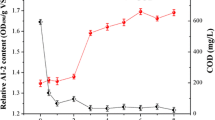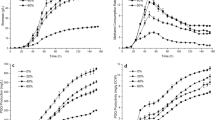Abstract
The metabolism of Bacillus thuringiensis during its sporulation process was investigated under different concentrations of oxygen. At the beginning of sporulation, the aeration conditions were regulated to obtain different oxygen transfer rates (OTR) in four separate fermentations, representing interrupted, limited, non-limited, and saturated oxygenation, respectively. A higher OTR resulted in a higher pH, up to about 9 in the case of saturated oxygenation, while the interrupted oxygenation resulted in a significantly acidic culture. In contrast, the absence of oxygen resulted in rapid sporangia lysis and caused acidification of the medium, indicating a distinctly different sporangia composition and different metabolism. The bacterium also showed different CO2 production rates during sporulation, although amaximum point was observed in every case.With a higher OTR, the maximal value was observed after a longer time and at a lower value (40, 26, and 13 mmol/L/h for limited, non-limited, and saturated cases, respectively). Despite the exhaustion of glucose prior to the sporulation phase, the interrupted oxygenation resulted in acetate, lactate, and citrate in the medium with a maximum concentration of 4.8, 1.3, and 5.0 g/L, respectively. Notwithstanding, while the metabolic events differed visibly in the absence of oxygen, once sporulation was triggered, it was completed, even in the case of an interrupted oxygen supply.
Similar content being viewed by others
Refrerences
Amicarelli, A., di Sciascio, F., Toibero, J.M., and Alvarez, H. 2010. Including dissolved oxygen dynamics into the Bt d-endotoxins production process model and its application to process control. Braz. J. Chem. Eng. 27, 41–62.
Arbige, M.V., Bulthuis, B.A., Schultz, J., and Crabb, D. 1993. Fermentation of Bacillus. pp. 871–895. In Sonenshein, A.L., Hoch, J.A., and Losick, R. (eds.), Bacillus subtilis and other Gram-positive bacteria. American Society for Microbiology, Washington, D.C., USA.
Aronson, J.N., Borris, D.P., Doerner, J.F., and Akers, E. 1975. Gamma-aminobutyric acid pathway and modified tricarboxylicacid cycle activity during growth and sporulation of Bacillus thuringiensis. Appl. Microbiol. 30, 489–492.
Avignone-Rossa, C., Arcas, J., and Mignone, C. 1992. Bacillus thuringiensis growth, sporulation and delta-endotoxin production in oxygen limited and non-limited cultures. World J. Microbiol. Biotechnol. 8, 301–304.
Avignone-Rossa, C. and Mignone, C.F. 1995. Bacillus thuringiensis growth and toxicity - basic applied considerations. Mol. Biotechnol. 4, 55–71.
Benoit, T.G., Wilson, G.R., and Baugh, C.L. 1990. Fermentation during growth and sporulation of Bacillus thuringiensis HD-1. Lett. Appl. Microbiol. 10, 15–18.
Berbert-Molina, M.A., Prata, A.M.R., Pessanha, L.G., and Silveira, M.M. 2008. Kinetics of Bacillus thuringiensis var. israelensis growth on high glucose concentrations. J. Ind. Microbiol. Biotechnol. 35, 1397–1404.
Boniolo, F.S., Rodrigues, R.C., Prata, A.M.R., Lopez, M.L., Jacinto, T., Silveira, M.M., and Berbert-Molina, M.A. 2012. Oxygen supply in Bacillus thuringiensis fermentations: bringing new insights on their impact on sporulation and d-endotoxin production. Appl. Microbiol. Biotechnol. 94, 625–636.
Buchanan, R.E. and Gibbons, N.E. 1974. Bergey’s manual of determinative bacteriology. pp. 529–545. American Society for Microbiology, Williams & Wilkins Co, Baltimore, USA.
Calik, P., Calik, G., and Ozdamar, G.H. 1998. Oxygen transfer effects in serine alkaline protease fermentation by Bacillus licheniformis: Use of citric acid as the carbon source. Enzyme Microb. Technol. 23, 451–461.
Clifton, C.E. and Sobek, J.M. 1961. Endogenous respiration of Bacillus cereus. J. Bacteriol. 82, 252–256.
Dang, N.D.P., Karrer, D.A., and Dunn, I.J. 1977. Oxygen transfer coefficients by dynamic model moment analysis. Biotechnol. Bioeng. 19, 853–865.
Dingman, D.W. and Stahly, D.P. 1984. Protection of Bacillus larvae from oxygen toxicity with emphasis on the role of catalase. Appl. Environ. Microbiol. 47, 1228–1237.
Ghribi, D., Zouari, N., Trabelsi, H., and Jaoua, S. 2007. Improvement of Bacillus thuringiensis delta-endotoxin production by overcome of carbon catabolite repression through adequate control of aeration. Enzyme Microb. Technol. 40, 614–622.
Kraemer-Schafhalter, A. and Moser, A. 1996. Kinetic study of Bacillus thuringiensis var. israelensis in lab-scale batch process. Bioprocess Eng. 14, 139–144.
Liu, W., Bajpai, R., and Bihari, V. 1994. High-density cultivation of sporeformers. Ann. N.Y. Acad. Sci. 721, 310–325.
López-y-López, V.E. and De la Torre, M. 2005. Redirection of metabolism during nutrient feeding in fed-batch cultures of Bacillus thuringiensis. Appl. Microbiol. Biotechnol. 67, 254–260.
Lüthy, P., Cordier, J.L., and Fisher, H.M. 1982. Microbial and viral pesticides. pp. 35–74. Marcel Dekker, NY, USA.
Madrid, R.E. and Felice, C.J. 2005. Microbial biomass estimation. Crit. Rev. Biotechnol. 25, 97–112.
Mignone, C.F. and Avignone-Rossa, C. 1996. Analysis of glucose carbon fluxes in continuous cultures of Bacillus thuringiensis. Appl. Microbiol. Biotechnol. 46, 78–84.
Nakata, H.M. 1963. Effect of pH on intermediates produced during growth and sporulation of Bacillus cereus. J. Bacteriol. 86, 577–581.
Nakata, H.M. and Halvorson, H.O. 1960. Biochemical changes occurring during growth and sporulation of Bacillus cereus. J. Bacteriol. 80, 801–810.
Nikolaev, P.I., Polyanskii, P.V., Kantere, V.M., and Kharitonova, E.V. 1976. Determination of the mass transfer coefficient with respect to oxygen in a gas-liquid system by use of membrane type sensor. Theor. Found. Chem. Eng. 10, 13–19.
Park, H.W., Brent, C.P., Switzerlyna, K.C., Erika, A.H., Ryan, M.O., Brian, A.F., and Dennis, K.B. 2013. Cyt1Aa from Bacillus thuringiensis subsp. israelensis enhances mosquitocidal activity of B. thuringiensis subsp. kurstaki HD-1 against Aedes aegypti but not Culex quinquefasciatus. J. Microbiol. Biotechnol. 23, 88–91.
Roh, J.Y., Choi, J.Y., Li, M.S., Jin, B.R., and Je, Y.H. 2007. Bacillus thuringiensis as a specific, safe, and effective tool for insect pest control. J. Microbiol. Biotechnol. 17, 547–559.
Rowe, G.E., Margaritis, A., and Wei, N. 2003. Specific oxygen uptake rate variations during batch fermentation of Bacillus thuringiensis subspecies kurstaki HD-1. Biotechnol. Prog. 19, 1439–1443.
Royce, P.N. 1992. Effect of changes in the pH and carbon dioxide evolution rate on the measured respiratory quotient of fermentations. Biotechnol. Bioeng. 40, 1129–1138.
Sarrafzadeh, M.H. 2012. Nutritional requirements of Bacillus thuringiensis during different phases of growth, sporulation and germination evaluated by plackett-burman method. Iran. J. Chemis. Chemic. Eng. 31, 131–136.
Sarrafzadeh, M.H., Belloy, L., Esteban, G., Navarro, J.M., and Ghommidh, C. 2005a. Dielectric monitoring of the growth and sporulation of Bacillus thuringiensis. Biotechnol. Lett. 27, 511–517.
Sarrafzadeh, M.H., Bigey, F., Capariccio, B., Mehrnia, M.R., Guiraud, J.P., and Navarro, J.M. 2007. Simple indicators of plasmid loss during fermentation of Bacillus thuringiensis. Enzyme Microb. Technol. 40, 1052–1058.
Sarrafzadeh, M.H., Guiraud, J.P., Lagneau, C., Gaven, B., Carron, A., and Navarro, J.M. 2005b. Growth, sporulation, d-endotoxins synthesis, and toxicity during culture of Bacillus thuringiensis H14. Curr. Microbiol. 51, 75–81.
Sarrafzadeh, M.H. and Navarro, J.M. 2006. The effect of oxygen on the sporulation, d-endotoxin synthesis and toxicity of Bacillus thuringiensis H14.World J. Microbiol. Biotechnol. 22, 305–310.
Schnepf, E., Crickmore, N., van Rie, J., Lereclus, D., Baum, J., Feitelson, J., Zeigler, D.R., and Dean, D.R. 1998. Bacillus thuringiensis and its pesticidal crystal proteins. Microbiol. Mol. Biol. Rev. 62, 775–806.
Silveira, M.M. and Molina, M.A.B. 2005. Indirect estimation of Bacillus thuringiensis var. israelensis biomass concentration using oxygen balance data. Braz. J. Chem. Eng. 22, 495–500.
Smith, T.J. and Foster, S.J. 1995. Characterization of the involvement of 2 compensatory autolysins in mother cell-lysis during sporulation of Bacillus subtilis. J. Bacteriol. 177, 3855–3862.
Sonenshein, A.L. 1989. Metabolic regulation of sporulation and other stationary-phase phenomena, pp. 109–130. In Smith, I., Slepecky, R.A., and Setlow, P. (eds.). Regulation of procaryotic development. American Society for Microbiology, Washington, D.C., USA.
Stragier, P. and Losick, R. 1996. Molecular genetics of sporulation in Bacillus subtilis. Ann. Rev. Genet. 30, 297–341.
Vinter, V. 1969. Physiology and biochemistry of sporulation, pp. 73–123. In Gould, G.W. and Hurst, A. (eds.). Bacterial spores, Academic Press, London, UK.
Wiechert, W. 2002. Modeling and simulation: tools for metabolic engineering. J. Biotechnol. 94, 37–63.
Yang, X.M. and Wang, S.S. 2000. Phase-specific optimization of multiple endotoxin-protein production with genetically engineered Bacillus thuringiensis. Biotechnol. Appl. Biochem. 31, 71–76.
Yousten, A.A. and Rogoff, M.H. 1969. Metabolism of Bacillus thuringiensis in relation to spore and crystal formation. J. Bacteriol. 100, 1229–1236.
Zouari, N., Achour, O., and Jaoua, S. 2002. Production of deltaendotoxin by Bacillus thuringiensis subsp. kurstaki and overcome of catabolite repression, by using highly concentrated gruel and fish meal media in 2 and 20 dm3 fermenters. J. Chem. Technol. Biotechnol. 77, 877–882.
Author information
Authors and Affiliations
Corresponding author
Rights and permissions
About this article
Cite this article
Sarrafzadeh, M.H., Schorr-Galindo, S., La, HJ. et al. Aeration effects on metabolic events during sporulation of Bacillus thuringiensis . J Microbiol. 52, 597–603 (2014). https://doi.org/10.1007/s12275-014-3547-9
Received:
Revised:
Accepted:
Published:
Issue Date:
DOI: https://doi.org/10.1007/s12275-014-3547-9




